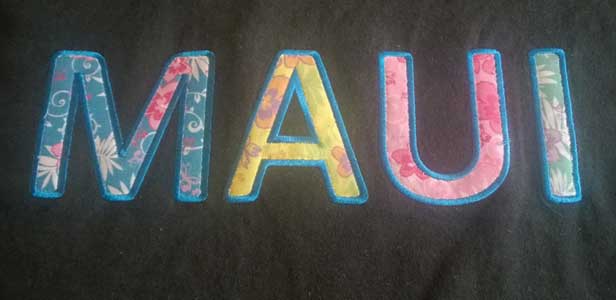Strategy July 26, 2019
How To Get Creative With Appliqué
This decoration technique is lucrative, cost efficient and unique.
Appliqué is a terrific way for embroiderers to reduce stitch counts on large designs, but it’s much more than that. This technique can also be a valuable artistic tool, particularly when decorators select fabric inserts with prints that add vibrancy and originality to a design.
Consider fabrics that are a natural companion to the design. If you’re working with a sailboat design, look for a material similar to sailcloth as an appliqué for the sails. True sailcloth would be too heavy, but there are plenty of polyesters that would be suitable.

Custom digital appliqué fabric can add dimension and visual interest to a design.
Another option is to select appliqué fabrics that become a focal point rather than a background element. I’ve used animal print fabric for a design targeted at zoos. The design itself was simple, embroidery-wise, but the unique prints in the appliqué made it shine.
This same approach can be used with almost any targeted marketplace: appliquéd letters for a high school using fabric inserts printed with the school mascot and colors or a modernistic hoodie for a college bookstore with a colorful, abstract-patterned appliqué. For corporate markets, the printed fabric can be used to further promote branding.
The key for all of these approaches, of course, is finding the right fabric. Traditionally, decorators would have had to scour fabric stores and attend fabric shows to find really cool prints to fuel their appliqué designs. Thanks to advances in digital printing, that’s no longer necessary. Decorators can create their own prints using sublimation or digital transfers.
Creating custom printed digital appliqué doesn’t require a huge investment, considering the low-entry costs of sublimation and digital transfer systems. An 8-inch-by-10-inch full-color design can be sublimated for as low as 40 cents, depending on the printer, inks and design details. Combine that with the reduction in stitch count by using appliqué in place of fill stitches, and you have a very cost-effective decoration that can command a significant markup due to the uniqueness of the embellishment.
Which printing method works best? The first concern is the fabric content. Sublimation works only with polyester fabrics, whereas cotton fabrics require cotton transfer inks and media, which can be heat-applied.
Fabric characteristics also play a part. Polyester holds up nicely to long-term wear and tear, and sublimation prints don’t fade, crack, shrink or peel over time – a definite plus. Cotton, on the other hand, tends to have a matte finish and textured surface, providing a lot of options for fabric selection. Though durable, cotton does have a tendency to shrink, which may affect the appearance of the appliqué over time. Cotton inks also tend to fade after multiple washings. While digital cotton printing is advanced enough to generate high-resolution images, sublimation typically outperforms it when photorealistic images are necessary.
Another point to consider is fabric color. Sublimation and cotton transfer inks must be used on white or light-colored fabrics. This isn’t really a hindrance, as you can create any background color you wish via digital printing. Simply start with white fabric, then add the necessary background colors when setting up your image. Leave white areas in the design open so the original fabric shows through.
Create your design, print it on the appropriate transfer paper and apply to the blank fabric with a heat press. You can apply your digital appliqué fabric using traditional or laser methods.
For the traditional method:
1. Cut out the appliqué shape from the fabric swatch you created digitally. (This can be done with scissors, though for large runs, you may wish to contract it out or invest in a cutter system.)
2. Sew the outline stitches.
3. Apply the precut appliqué fabric using a light adhesive. Use the outline stitches as a reference for placement.
4. Sew the tack-down stitches to secure the fabric.
5. Sew the final border stitches to finish securing and give a nice finished look to the edges.
Many shops have invested in a textile laser, greatly simplifying the appliqué process, especially when dealing with complex shapes, multiple segments and reverse appliqué. The laser will trim your appliqué fabric for you after the tack-down stitches have been sewn.
Digital appliqué adds excitement and creativity to any garment. It’s quick, easy and inexpensive. Best of all, it commands decent markups and sets you apart from the competition.
Jimmy Lamb is an award-winning author and international speaker with more than 25 years of experience in the apparel decoration business. Currently, he’s the manager of communications at Sawgrass Technologies.
